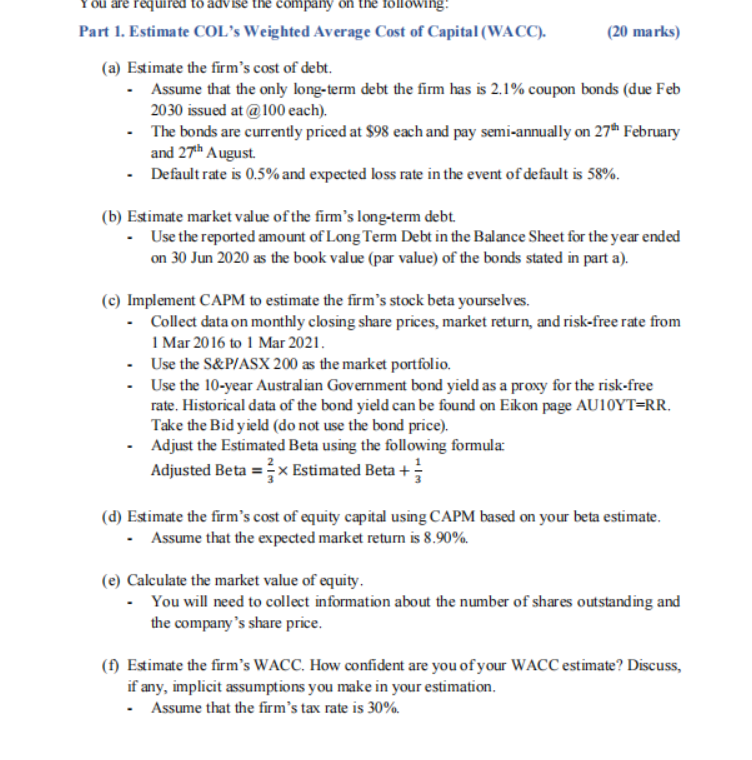
ou are required to the company on the following: Part 1. Estimate COL's Weighted Average Cost of Capital (WACC). (20 marks) (a) Estimate the firm's cost of debt. - Assume that the only long-term debt the firm has is 2.1% coupon bonds (due Feb 2030 issued at @ 100 each). The bonds are currently priced at $98 each and pay semi-annually on 27 February and 27th August Default rate is 0.5% and expected loss rate in the event of default is 58%. (b) Estimate market value of the firm's long-term debt. - Use the reported amount of Long Term Debt in the Balance Sheet for the year ended on 30 Jun 2020 as the book value (par value) of the bonds stated in part a). (C) Implement CAPM to estimate the firm's stock beta yourselves, Collect data on monthly closing share prices, market return, and risk-free rate from 1 Mar 2016 to 1 Mar 2021. - Use the S&P/ASX 200 as the market portfolio. Use the 10-year Australian Government bond yield as a proxy for the risk-free rate. Historical data of the bond yield can be found on Eikon page AU1OYT=RR. Take the Bid yield (do not use the bond price) Adjust the Estimated Beta using the following formula Adjusted Beta = {x Estimated Beta + (d) Estimate the firm's cost of equity capital using CAPM based on your beta estimate. - Assume that the expected market return is 8.90%. (e) Calculate the market value of equity. - You will need to collect information about the number of shares outstanding and the company's share price. (1) Estimate the firm's WACC. How confident are you of your WACC estimate? Discuss, if any, implicit assumptions you make in your estimation. - Assume that the firm's tax rate is 30%. ou are required to the company on the following: Part 1. Estimate COL's Weighted Average Cost of Capital (WACC). (20 marks) (a) Estimate the firm's cost of debt. - Assume that the only long-term debt the firm has is 2.1% coupon bonds (due Feb 2030 issued at @ 100 each). The bonds are currently priced at $98 each and pay semi-annually on 27 February and 27th August Default rate is 0.5% and expected loss rate in the event of default is 58%. (b) Estimate market value of the firm's long-term debt. - Use the reported amount of Long Term Debt in the Balance Sheet for the year ended on 30 Jun 2020 as the book value (par value) of the bonds stated in part a). (C) Implement CAPM to estimate the firm's stock beta yourselves, Collect data on monthly closing share prices, market return, and risk-free rate from 1 Mar 2016 to 1 Mar 2021. - Use the S&P/ASX 200 as the market portfolio. Use the 10-year Australian Government bond yield as a proxy for the risk-free rate. Historical data of the bond yield can be found on Eikon page AU1OYT=RR. Take the Bid yield (do not use the bond price) Adjust the Estimated Beta using the following formula Adjusted Beta = {x Estimated Beta + (d) Estimate the firm's cost of equity capital using CAPM based on your beta estimate. - Assume that the expected market return is 8.90%. (e) Calculate the market value of equity. - You will need to collect information about the number of shares outstanding and the company's share price. (1) Estimate the firm's WACC. How confident are you of your WACC estimate? Discuss, if any, implicit assumptions you make in your estimation. - Assume that the firm's tax rate is 30%







